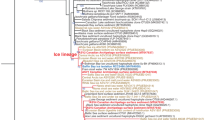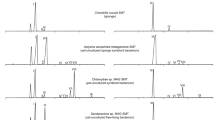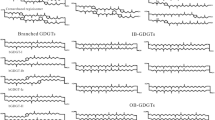Abstract
STEROIDAL alcohols (sterols) are fundamental biochemicals in eukaryotes and are indicators of organic matter sources and transformations in sea water and sediments1–3. Reduction of Δ5-stenols, the predominant biogenic sterols, to 5α(H)-stanoIs is primarily an anaerobic microbial transformation4,5. Increased stanol/stenol ratios are used as evidence of this process, for example in Recent sediments where stanol/stenol ratios are higher at lower redox potential2,6–9. The oxic nature of sea water generally seems to preclude this conversion10–12. However, increased stanol/stenol ratios can also reflect direct biogenic input of stanols or preferential degradation of stenols relative to stanols. Here I report increased 5α(H)-stanol/Δ5-stenol ratios in particulate matter at the oxic-anoxic interfaces in the water columns of the Cariaco Trench and Black Sea and attribute them to in situ microbial conversion of stenol to stanol. The extent of conversion varies with water-column redox potential: little stanol generation occurs under oxic conditions, whereas there is substantial conversion in anoxic waters. These results imply that anoxic waters, particularly near oxic–anoxic interfaces, are important sites of intense alteration of organic matter.
This is a preview of subscription content, access via your institution
Access options
Subscribe to this journal
Receive 51 print issues and online access
$199.00 per year
only $3.90 per issue
Buy this article
- Purchase on Springer Link
- Instant access to full article PDF
Prices may be subject to local taxes which are calculated during checkout
Similar content being viewed by others
References
Mackenzie, A. S., Brassell, S. C., Eglinton, G. & Maxwell, J. R. Science 217, 491–504 (1982).
Gagosian, R. B., Smith, S. O., Lee, C., Farrington, J. W. & Frew, N. M. in Advances in Organic Geochemistry 1979 (eds Douglas, A. G. & Maxwell, J. R.) (Pergamon, New York, 1980).
Brassell, S. C. & Eglinton, G. in Advances in Organic Geochemistry 1981 (eds Bjorøy, M. et al.) (Wiley, Chichester, 1983).
Eyssen, H. J., Parmentier, G. C., Compernoll, F. C., De Pauw, G. & Piessenes-Denet, G. Eur. J. Biochem. 36, 411–421 (1973).
Rosenfeld, R. S. & Hellman, L. J. Lipid. Res. 12, 192–197 (1971).
Gaskell, S. J. & Eglinton, G. Nature 254, 209–211 (1976).
Nishimura, M. & Koyama, T. Geochim. cosmochim. Acta 41, 371–385 (1977).
Nishimura, M. Geochim. cosmochim. Acta 42, 349–357 (1978).
Nishimura, M. Geochim. cosmochim. Acta 41, 1817–1823 (1977).
Gagosian, R. B., Smith, S. O. & Nigrelli, G. E. Geochim. cosmochim. Acta 46, 1163–1172 (1982).
Wakeham, S. G. & Canuel, E. A. J. mar. Res. 46, 183–213 (1988).
Wakeham, S. G. & Lee, C. Org. Geochem. 14, 83–96 (1989).
Wakeham, S. G. Geochim. cosmochim. Acta 51, 3051–3069 (1987).
Wakeham, S. G. & Ertel, J. R. Org. Geochem. 13, 815–822 (1988).
Goad, L. J. in Marine Natural Products, Chemical and Biological Perspectives (ed. Scheur, P. J.) (Academic, New York, 1978).
Nes, W. R. & McKean, M. L. Biochemistry of Steroids and Other Isopentenoids (University Park Press, Baltimore, 1977).
Jannasch, H. W., Trüper, H. G. & Tuttle, J. H. in The Black Sea—Geology, Chemistry and Biology Mem. No. 20 (eds Degens, E. & Ross, D.) (A. M. Ass. Petrol. Geol., Tulsa, 1974).
Karl, D. M. Limnol. Oceanogr. 23, 936–949 (1978).
Karl, D. M. & Knauer, G. A. Deep Sea Res. 31, 221–243 (1984).
Morris, I., Glover, H. E., Kaplan, W. A., Kelley, D. P. & Weightman, A. L. Microbios 42, 133–144 (1985).
Karl, D. M., LaRock, P. A. & Schulz, D. J. Deep Sea Res. 24, 105–113 (1977).
Bird, C. W., Lynch, J. M., Pirt, F. J., Brooks, C. J. W. & Middleditch, B. S. Nature 230, 473–474 (1976).
Bouvier, P., Rohmer, M., Benveniste, P. & Ourisson, G. Biochem. J. 159, 267–271 (1976).
Bada, J. L. Adv. Chem. Ser. 106, 309–331 (1971).
Gagosian, R. B. & Heinzer, F. Geochim. cosmochim. Acta 43, 471–486 (1979).
Broenkow, W. W. & Reaves, R. E. Moss Landing Mar. Lab. Tech. Publ. No. 85-1 (Moss Landing Mar. Lab., Moss Landing, 1985).
Broenkow, W. W. & Krenz, R. Moss Landing Mar. Lab. Techn. Publ. No. 82-1 (Moss Landing Mar. Lab., Moss Landing, 1982).
Broenkow, W. W., Lewitus, A. J. & Reaves, R. E. Moss Landing Mar. Lab. Tech. Publ. No. 83-1 (Moss Landing Mar. Lab., Moss Landing, 1983).
White, G., Relander, M., Postel, J. & Murray, J. W. School of Oceanography Spec. Rep. No. 109 (University of Washington, Seattle, 1989).
Author information
Authors and Affiliations
Rights and permissions
About this article
Cite this article
Wakeham, S. Reduction of stenols to stanols in particulate matter at oxic–anoxic boundaries in sea water. Nature 342, 787–790 (1989). https://doi.org/10.1038/342787a0
Received:
Accepted:
Issue Date:
DOI: https://doi.org/10.1038/342787a0
This article is cited by
-
Understanding controls on stanols in lake sediments as proxies for palaeopopulations in Mesoamerica
Journal of Paleolimnology (2022)
-
Last glacial terrestrial vegetation record of leaf wax n-alkanols in the northern South China Sea: Contrast to scenarios from long-chain n-alkanes
Acta Oceanologica Sinica (2022)
-
Lipid biomarker composition in surface sediments from the Carlsberg Ridge near the Tianxiu Hydrothermal Field
Acta Oceanologica Sinica (2021)
-
Looking for Ancient Fish Products Through Invisible Biomolecular Residues in the Roman Production Vats from the Atlantic Coast
Journal of Maritime Archaeology (2018)
-
Molecular Biosignatures
Space Science Reviews (2008)
Comments
By submitting a comment you agree to abide by our Terms and Community Guidelines. If you find something abusive or that does not comply with our terms or guidelines please flag it as inappropriate.



